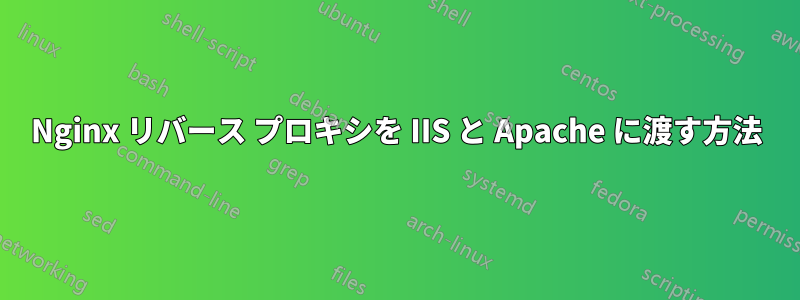
私はしばらくの間このシナリオに対処してきましたが、これにつながるエラーや構成を見つけることができません。 ドメイン example.com が 1 つとサブドメインが複数あります (app.example.com、test.example.com など)。 ポート 80 と 443 は、VM (IP 10.10.10.10) によって Nginx サーバーを指しています。 また、IIS ポート 80 と 443 を提供する Windows Server を搭載した VM もあります (この Web サーバー example.com/_/login?returnurl= は、ルーターでポートをこの VM にルーティングすると正常に動作します (この VM はすべてクラウド インフラストラクチャ上にあります)。したがって、IIS は正常に動作しています。
一方、私はサブドメイン app.example.com 上の SSL (certbot でインストール済み) を備えた別の VM (IP 10.10.10.11) 上の Apache Web サーバーで動作する Web アプリを持っています。
Nginx リバース プロキシを通過する場合も正常に動作します。これはそのサーバーの設定ファイルです:
server {
server_name app.example.com.ar www.app.example.com.ar;
location / {
proxy_pass http://10.10.10.2/;
}
listen 443 ssl; # managed by Certbot
ssl_certificate /etc/letsencrypt/live/app.example.com.ar/fullchain.pem; # managed by Certbot
ssl_certificate_key /etc/letsencrypt/live/app.example.com.ar/privkey.pem; # managed by Certbot
include /etc/letsencrypt/options-ssl-nginx.conf; # managed by Certbot
ssl_dhparam /etc/letsencrypt/ssl-dhparams.pem; # managed by Certbot
}
server {
if ($host = app.example.com.ar) {
return 301 https://$host$request_uri;
} # managed by Certbot
listen 80;
server_name app.example.com.ar www.app.example.com.ar;
return 404; # managed by Certbot
}
ここで物事が混乱します:
http example.com (iis にサービスを提供) を取得しようとすると、nginx を通過して app.example.com の Apache Web サーバーが取得されます。サイトの完全な URL example.com/_/login?returnurl= を取得しようとすると、Apache エラー 404 が返されます。
なぜこうなった?
TLDR: Web サーバー (IIS および Apache) を備えた複数の VM があり、nginx リバース プロキシ経由でリダイレクトを試みており、すべての http 要求が Apache Web サーバーに送信されます。
# configuration file /etc/nginx/nginx.conf:
user www-data;
worker_processes auto;
pid /run/nginx.pid;
include /etc/nginx/modules-enabled/*.conf;
events {
worker_connections 768;
# multi_accept on;
}
http {
##
# Basic Settings
##
sendfile on;
tcp_nopush on;
types_hash_max_size 2048;
# server_tokens off;
# server_names_hash_bucket_size 64;
# server_name_in_redirect off;
include /etc/nginx/mime.types;
default_type application/octet-stream;
##
# SSL Settings
##
ssl_protocols TLSv1 TLSv1.1 TLSv1.2 TLSv1.3; # Dropping SSLv3, ref: POODLE
ssl_prefer_server_ciphers on;
##
# Logging Settings
##
access_log /var/log/nginx/access.log;
error_log /var/log/nginx/error.log;
##
# Gzip Settings
##
gzip on;
# gzip_vary on;
# gzip_proxied any;
# gzip_comp_level 6;
# gzip_buffers 16 8k;
# gzip_http_version 1.1;
# gzip_types text/plain text/css application/json application/javascript text/xml application/xml application/xml+rss text/javascript;
##
# Virtual Host Configs
##
include /etc/nginx/conf.d/*.conf;
include /etc/nginx/sites-enabled/*;
}
#mail {
# # See sample authentication script at:
# # http://wiki.nginx.org/ImapAuthenticateWithApachePhpScript
#
# # auth_http localhost/auth.php;
# # pop3_capabilities "TOP" "USER";
# # imap_capabilities "IMAP4rev1" "UIDPLUS";
#
# server {
# listen localhost:110;
# protocol pop3;
# proxy on;
# }
#
# server {
# listen localhost:143;
# protocol imap;
# proxy on;
# }
#}
# configuration file /etc/nginx/mime.types:
types {
text/html html htm shtml;
text/css css;
text/xml xml;
image/gif gif;
image/jpeg jpeg jpg;
application/javascript js;
application/atom+xml atom;
application/rss+xml rss;
text/mathml mml;
text/plain txt;
text/vnd.sun.j2me.app-descriptor jad;
text/vnd.wap.wml wml;
text/x-component htc;
image/png png;
image/tiff tif tiff;
image/vnd.wap.wbmp wbmp;
image/x-icon ico;
image/x-jng jng;
image/x-ms-bmp bmp;
image/svg+xml svg svgz;
image/webp webp;
application/font-woff woff;
application/java-archive jar war ear;
application/json json;
application/mac-binhex40 hqx;
application/msword doc;
application/pdf pdf;
application/postscript ps eps ai;
application/rtf rtf;
application/vnd.apple.mpegurl m3u8;
application/vnd.ms-excel xls;
application/vnd.ms-fontobject eot;
application/vnd.ms-powerpoint ppt;
application/vnd.wap.wmlc wmlc;
application/vnd.google-earth.kml+xml kml;
application/vnd.google-earth.kmz kmz;
application/x-7z-compressed 7z;
application/x-cocoa cco;
application/x-java-archive-diff jardiff;
application/x-java-jnlp-file jnlp;
application/x-makeself run;
application/x-perl pl pm;
application/x-pilot prc pdb;
application/x-rar-compressed rar;
application/x-redhat-package-manager rpm;
application/x-sea sea;
application/x-shockwave-flash swf;
application/x-stuffit sit;
application/x-tcl tcl tk;
application/x-x509-ca-cert der pem crt;
application/x-xpinstall xpi;
application/xhtml+xml xhtml;
application/xspf+xml xspf;
application/zip zip;
application/octet-stream bin exe dll;
application/octet-stream deb;
application/octet-stream dmg;
application/octet-stream iso img;
application/octet-stream msi msp msm;
application/vnd.openxmlformats-officedocument.wordprocessingml.document docx;
application/vnd.openxmlformats-officedocument.spreadsheetml.sheet xlsx;
application/vnd.openxmlformats-officedocument.presentationml.presentation pptx;
audio/midi mid midi kar;
audio/mpeg mp3;
audio/ogg ogg;
audio/x-m4a m4a;
audio/x-realaudio ra;
video/3gpp 3gpp 3gp;
video/mp2t ts;
video/mp4 mp4;
video/mpeg mpeg mpg;
video/quicktime mov;
video/webm webm;
video/x-flv flv;
video/x-m4v m4v;
video/x-mng mng;
video/x-ms-asf asx asf;
video/x-ms-wmv wmv;
video/x-msvideo avi;
}
# configuration file /etc/nginx/sites-enabled/app.example.com.ar:
server {
server_name app.example.com.ar www.app.example.com.ar;
location / {
proxy_pass http://10.10.10.2/;
}
listen 443 ssl; # managed by Certbot
ssl_certificate /etc/letsencrypt/live/app.example.com.ar/fullchain.pem; # managed by Certbot
ssl_certificate_key /etc/letsencrypt/live/app.example.com.ar/privkey.pem; # managed by Certbot
include /etc/letsencrypt/options-ssl-nginx.conf; # managed by Certbot
ssl_dhparam /etc/letsencrypt/ssl-dhparams.pem; # managed by Certbot
}
server {
if ($host = app.example.com.ar) {
return 301 https://$host$request_uri;
} # managed by Certbot
listen 80;
server_name app.example.com.ar www.app.example.com.ar;
return 404; # managed by Certbot
}
# configuration file /etc/letsencrypt/options-ssl-nginx.conf:
# This file contains important security parameters. If you modify this file
# manually, Certbot will be unable to automatically provide future security
# updates. Instead, Certbot will print and log an error message with a path to
# the up-to-date file that you will need to refer to when manually updating
# this file. Contents are based on https://ssl-config.mozilla.org
ssl_session_cache shared:le_nginx_SSL:10m;
ssl_session_timeout 1440m;
ssl_session_tickets off;
ssl_protocols TLSv1.2 TLSv1.3;
ssl_prefer_server_ciphers off;
ssl_ciphers "ECDHE-ECDSA-AES128-GCM-SHA256:ECDHE-RSA-AES128-GCM-SHA256:ECDHE-ECDSA-AES256-GCM-SHA384:ECDHE-RSA-AES256-GCM-SHA384:ECDHE-ECDSA-CHACHA20-POLY1305:ECDHE-RSA-CHACHA20-POLY1305:DHE-RSA-AES128-GCM-SHA256:DHE-RSA-AES256-GCM-SHA384";
# configuration file /etc/nginx/sites-enabled/reverseproxy.conf:
server {
listen 80;
server_name _;
location / {
proxy_pass http://10.10.10.196:80;
proxy_http_version 1.1;
proxy_set_header Upgrade $http_upgrade;
proxy_set_header Connection keep-alive;
proxy_set_header Host $host;
proxy_cache_bypass $http_upgrade;
proxy_set_header X-Forwarded-For $proxy_add_x_forwarded_for;
proxy_set_header X-Forwarded-Proto $scheme;
}
}
さらに詳しい情報やその他の情報が必要な場合はお知らせください
助けて頂ければ嬉しいです!
答え1
example.comの DNS エントリは、質問に示されている構成を持つサーバーを指していると想定しています。
この構成では、3 つの仮想ホストが定義されています。
server {
server_name app.example.com.ar www.app.example.com.ar;
listen 443 ssl; # managed by Certbot
location / {
proxy_pass http://10.10.10.2/;
}
}
server {
listen 80;
server_name app.example.com.ar www.app.example.com.ar;
}
server {
listen 80;
server_name _;
location / {
proxy_pass http://10.10.10.196:80;
}
}
app.example.com.ar最初のホストはポート 443 (TLS)にあり、 にリバース プロキシします10.10.10.2。
2 番目のホストはapp.example.com.arポート 80 (HTTP) 用で、404 が見つかりませんを返します。
3 番目には定義がありませんserver_name。
Hostnginx は、HTTP リクエストのヘッダーまたはSNITLS ClientHello パケットのフィールドをチェックして、使用する仮想ホストを選択します。
リクエストから名前を取得し、serverポートに一致するブロックを検索します。
あなたの場合、 へのリクエストは、がに設定されているhttp://example.com.arブロックを nginx が検索しようとすることを意味します。そのようなブロックは存在しないため、nginx はデフォルトのブロックを使用します。server_name example.com.arlisten80
server指定されたエントリがないためdefault_server、nginx は最初に一致するserverブロックをデフォルトとして使用してリクエストを処理します。この場合、2 番目のブロックです。そのサーバー ブロックでは、アクションは でありreturn 404;、ブラウザーで確認できます。
server_nameこの問題を解決するには、 3 番目のブロックを適切に設定する必要があります。


